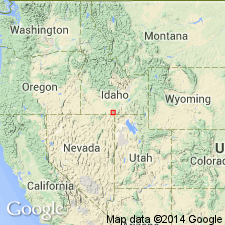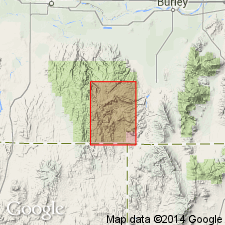
- Usage in publication:
-
- Third Fork Formation*
- Modifications:
-
- Named
- Dominant lithology:
-
- Mudstone
- Siltstone
- AAPG geologic province:
-
- Great Basin province
Summary:
Named. Type section designated and measured (graphic column) as S1/2 sec 17, T14S, R19E, Pike and Trapper quads, ID in the Great basin. Composed of gray, buff and pink sandy siltstone. Quartz is major component and calcite the major cement. Is bioturbated. Three distinct beds of argillaceous, spiculitic, black, lime-mudstone and calcareous siltstone at type section, where the formation is 331 m thick. Conformably overlies Wahlstrom Hollow Formation (named). Underlies Badger Gulch Formation (named). Is poorly fossiliferous; has diverse trace fossils. Is of Early Permian, late Wolfcampian age. Boundary arbitrarily placed at top of Third Fork. May have been deposited under aerobic (most of formation) to dysaerobic (top) conditions possibly in an extension of the Oquirrh basin. Characterized by trace fossils. Is poorly exposed. Forms slopes.
Source: GNU records (USGS DDS-6; Denver GNULEX).

- Usage in publication:
-
- Third Fork Formation*
- Modifications:
-
- Areal extent
- Overview
- Dominant lithology:
-
- Sandstone
- AAPG geologic province:
-
- Great Basin province
Summary:
Mapped in the Little Pigeon Mountains in northeast part of quad, Box Elder Co, UT in the Great Basin province. Unconformably? overlies Strathearn? Formation. Conformably underlies Badger Gulch Formation. Is 580 ft thick in south and 820 ft thick in north. Basal 32 to 130 ft is poorly exposed, yellow to brown calcareous sandstone. Overlying part is moderately resistant, thick-bedded, gray (weathers brown) sandstone. Some sandy, silty, fossiliferous (brachiopods, gastropods, fusulinids) limestone beds. Correlated with lower part of Pequop? Formation of Pilot Range. Rocks assigned to Third Fork in the Little Pigeon Mountains in this report were assigned to unit 3 of the Oquirrh Formation by an earlier worker. Assigned to the Permian. [Lithologic description of formation in this quad is different than description of it in the Cassia Mountains.]
Source: GNU records (USGS DDS-6; Denver GNULEX).

- Usage in publication:
-
- Third Fork Formation*
- Modifications:
-
- Overview
- AAPG geologic province:
-
- Great Basin province
Summary:
Mapped in northwest part of quad, Great Basin province, where it has gradational contacts with the older Wahlstrom Hollow Formation of Early Permian age and with the younger Badger Gulch Formation of Early Permian age. Forms steep to gentle slopes. Is 330 m thick. Of Early Permian age. [See also Stricker 1 quadrangle.]
Source: GNU records (USGS DDS-6; Denver GNULEX).
For more information, please contact Nancy Stamm, Geologic Names Committee Secretary.
Asterisk (*) indicates published by U.S. Geological Survey authors.
"No current usage" (†) implies that a name has been abandoned or has fallen into disuse. Former usage and, if known, replacement name given in parentheses ( ).
Slash (/) indicates name conflicts with nomenclatural guidelines (CSN, 1933; ACSN, 1961, 1970; NACSN, 1983, 2005, 2021). May be explained within brackets ([ ]).

